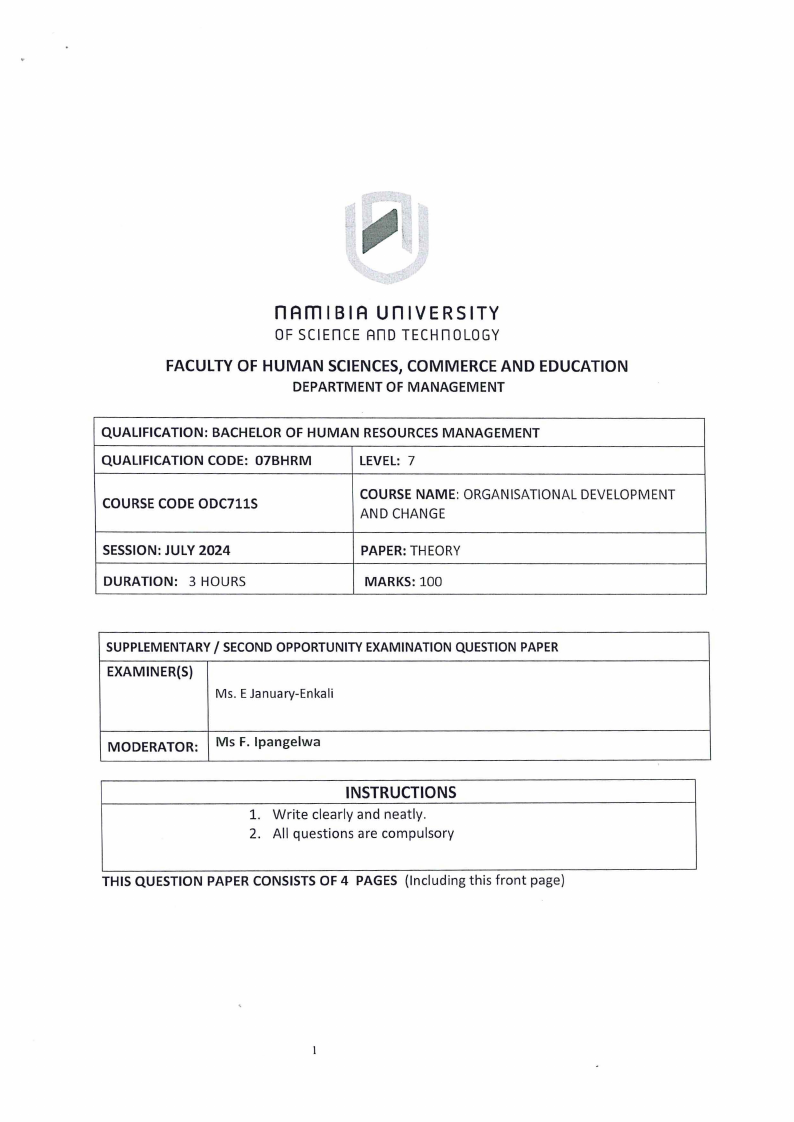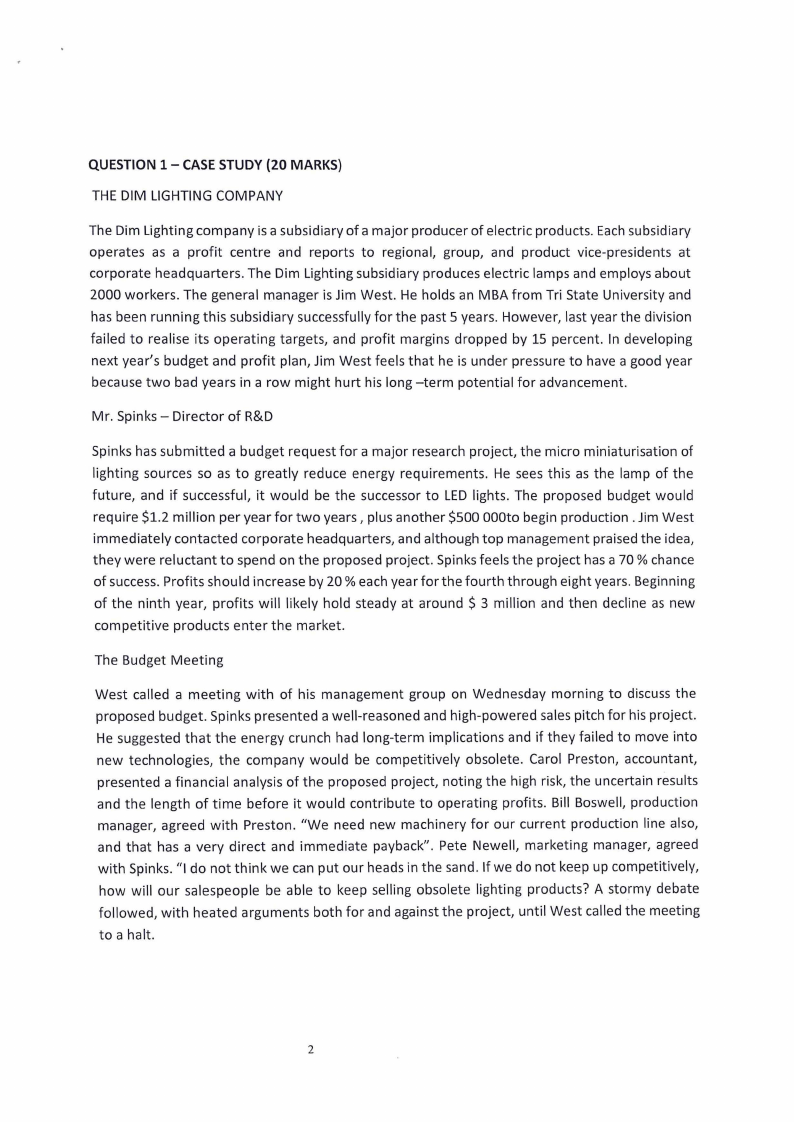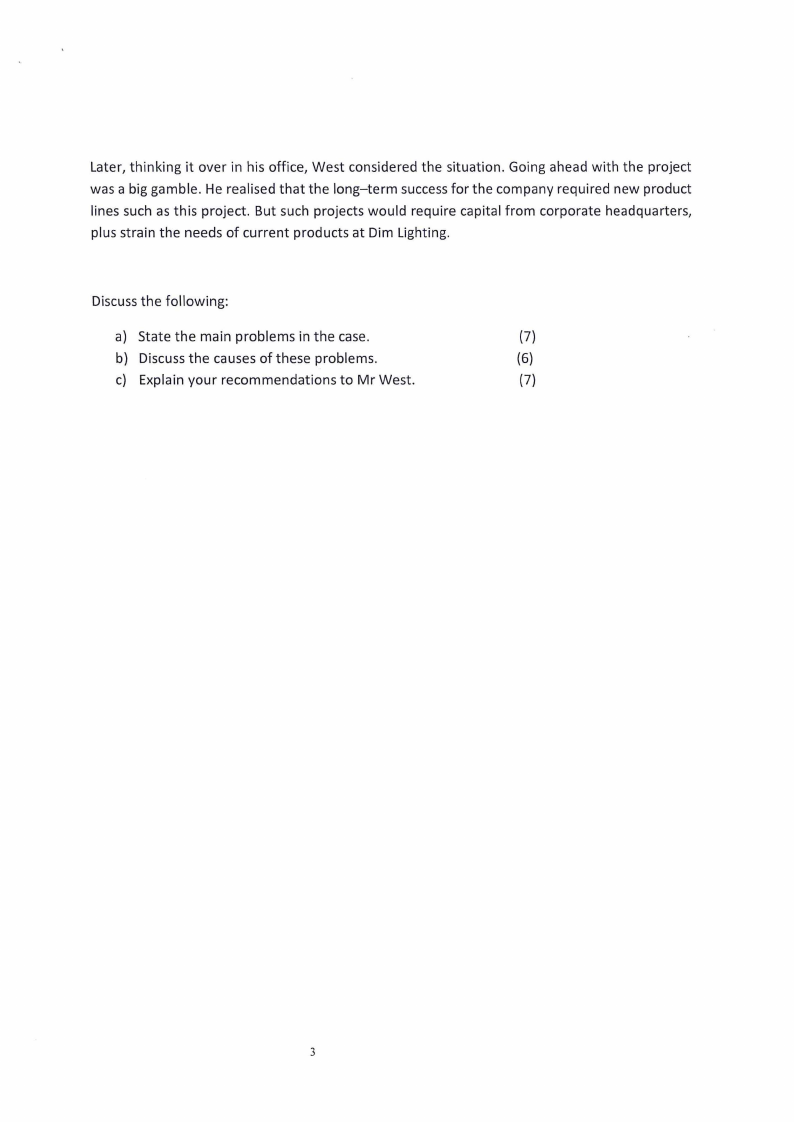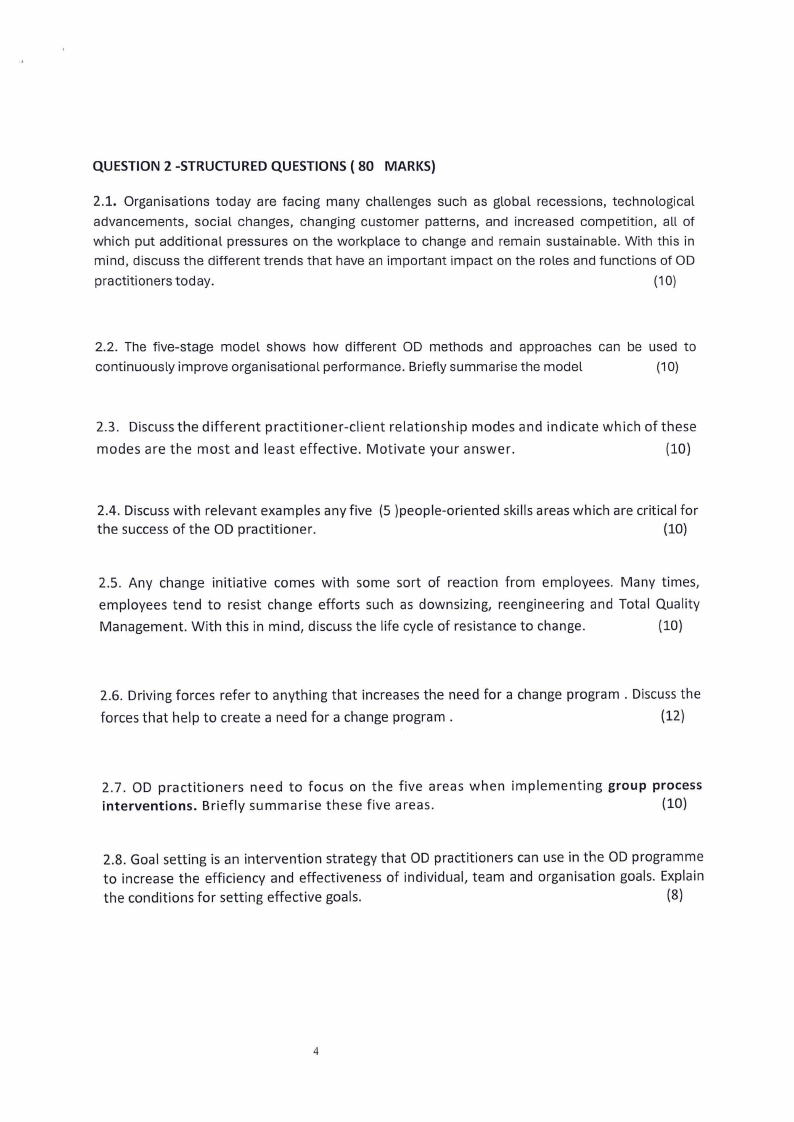 |
ODC711S - ORGANISATIONAL DEVELOPMENT AND CHANGE - 2ND OPP - JUNE 2024 |
 |
1 Page 1 |
▲back to top |

nAmlBIA unlVERSITY
OF SCIEnCE Ano TECHnOLOGY
FACULTY OF HUMAN SCIENCES, COMMERCE AND EDUCATION
DEPARTMENT OF MANAGEMENT
QUALIFICATION: BACHELOR OF HUMAN RESOURCES MANAGEMENT
QUALIFICATION CODE: 07BHRM
LEVEL: 7
COURSE CODE ODC711S
COURSE NAME: ORGANISATIONALDEVELOPMENT
AND CHANGE
SESSION: JULY 2024
DURATION: 3 HOURS
PAPER: THEORY
MARKS: 100
SUPPLEMENTARY/ SECOND OPPORTUNITY EXAMINATION QUESTION PAPER
EXAMINER{S)
Ms. EJanuary-Enkali
MODERATOR: Ms F. lpangelwa
INSTRUCTIONS
1. Write clearly and neatly.
2. All questions are compulsory
THIS QUESTION PAPER CONSISTS OF 4 PAGES (Including this front page)
 |
2 Page 2 |
▲back to top |

QUESTION1 - CASESTUDY{20 MARKS}
THE DIM LIGHTING COMPANY
The Dim Lighting company is a subsidiary of a major producer of electric products. Eachsubsidiary
operates as a profit centre and reports to regional, group, and product vice-presidents at
corporate headquarters. The Dim Lighting subsidiary produces electric lamps and employs about
2000 workers. The general manager is Jim West. He holds an MBA from Tri State University and
has been running this subsidiary successfully for the past 5 years. However, last year the division
failed to realise its operating targets, and profit margins dropped by 15 percent. In developing
next year's budget and profit plan, Jim West feels that he is under pressure to have a good year
because two bad years in a row might hurt his long -term potential for advancement.
Mr. Spinks - Director of R&D
Spinks has submitted a budget request for a major research project, the micro miniaturisation of
lighting sources so as to greatly reduce energy requirements. He sees this as the lamp of the
future, and if successful, it would be the successor to LED lights. The proposed budget would
require $1.2 million per year for two years, plus another $500 000to begin production . Jim West
immediately contacted corporate headquarters, and although top management praised the idea,
they were reluctant to spend on the proposed project. Spinks feels the project has a 70 % chance
of success. Profits should increase by 20 % each year for the fourth through eight years. Beginning
of the ninth year, profits will likely hold steady at around $ 3 million and then decline as new
competitive products enter the market.
The Budget Meeting
West called a meeting with of his management group on Wednesday morning to discuss the
proposed budget. Spinks presented a well-reasoned and high-powered sales pitch for his project.
He suggested that the energy crunch had long-term implications and if they failed to move into
new technologies, the company would be competitively obsolete. Carol Preston, accountant,
presented a financial analysis of the proposed project, noting the high risk, the uncertain results
and the length of time before it would contribute to operating profits. Bill Boswell, production
manager, agreed with Preston. "We need new machinery for our current production line also,
and that has a very direct and immediate payback". Pete Newell, marketing manager, agreed
with Spinks. "I do not think we can put our heads in the sand. If we do not keep up competitively,
how will our salespeople be able to keep selling obsolete lighting products? A stormy debate
followed, with heated arguments both for and against the project, until West called the meeting
to a halt.
2
 |
3 Page 3 |
▲back to top |

Later, thinking it over in his office, West considered the situation. Going ahead with the project
was a big gamble. He realised that the long-term success for the company required new product
lines such as this project. But such projects would require capital from corporate headquarters,
plus strain the needs of current products at Dim Lighting.
Discuss the following:
a) State the main problems in the case.
(7)
b) Discuss the causes of these problems.
(6)
c) Explain your recommendations to Mr West.
(7)
3
 |
4 Page 4 |
▲back to top |

QUESTION 2 -STRUCTURED QUESTIONS ( 80 MARKS)
2.1. Organisations today are facing many challenges such as global recessions, technological
advancements, social changes, changing customer patterns, and increased competition, all of
which put additional pressures on the workplace to change and remain sustainable. With this in
mind, discuss the different trends that have an important impact on the roles and functions of OD
practitioners today.
(10)
2.2. The five-stage model shows how different OD methods and approaches can be used to
continuously improve organisational performance. Briefly summarise the model
(10)
2.3. Discuss the different practitioner-client relationship modes and indicate which of these
modes are the most and least effective. Motivate your answer.
(10)
2.4. Discuss with relevant examples any five (5 )people-oriented skills areas which are critical for
the success of the OD practitioner.
(10)
2.5. Any change initiative comes with some sort of reaction from employees. Many times,
employees tend to resist change efforts such as downsizing, reengineering and Total Quality
Management. With this in mind, discuss the life cycle of resistance to change.
(10)
2.6. Driving forces refer to anything that increases the need for a change program . Discuss the
forces that help to create a need for a change program .
(12)
2.7. OD practitioners need to focus on the five areas when implementing group process
interventions. Briefly summarise these five areas.
(10)
2.8. Goal setting is an intervention strategy that OD practitioners can use in the OD programme
to increase the efficiency and effectiveness of individual, team and organisation goals. Explain
the conditions for setting effective goals.
(8)
4





